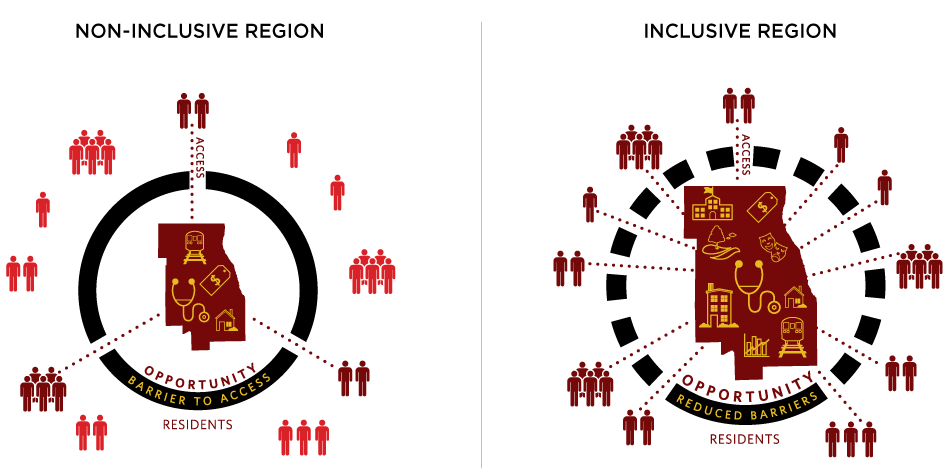Inclusive Growth Communities: New Strategies for Prosperity


While the U.S. economy has been on the upswing since 2009, that prosperity is not shared by all. “Business as usual” is not working for everyone.
Evidence suggests that fully half of American workers have experienced little to no income growth in decades (Frank & Chin, 2017). The once assured prospect that children would enjoy higher incomes than their parents has dimmed. And that stagnation is reshaping our society. Dragged down by debt and growing inequity, many Americans are cut off from opportunity and from the traditional markers of the American dream.
Moved by widespread concern about the scale and consequences of these disparities, many urban and regional leaders across the country are pushing action. They’re leading the charge, turning to a new concept and shared language to tackle the challenge. Their strategy is called inclusive growth (Liu 2017).
Inclusive growth means that more people share in the rewards of a growing economy and community. Inclusive growth communities are those that invest — through philanthropy, public policy, financial decisions, and community commitments — in the success of efforts like:
Evidence suggests that collaborations across the public, private, and nonprofit sectors are the critical factor in tackling this complexity and creating community success. Building coalitions that utilize a more diverse set of firms, workers, and communities to reach their productive potential offers a compelling opportunity for growth. Robert Giloth (2017) also calls this long-term, collaborative practice, “generative philanthropy.”
“Evidence suggests that collaborations across the public, private, and nonprofit sectors are the critical factor in tackling this complexity and creating community success. Building coalitions that utilize a more diverse set of firms, workers, and communities to reach their productive potential offers a compelling opportunity for growth.”
These coalitions have a unique ability to address barriers by stimulating job creation, empowering workers with the skills they need to fill good jobs, and ensuring all communities, regardless of their ZIP code, can physically and socially access jobs and educational opportunities.
The philanthropic sector can be a substantial economic driver for communities through strategies of economic inclusion and competitiveness. Current data from a variety of sources reveal that investments in economic development through grants, technical assistance, program-related investments, policy advocacy, and civic leadership have increased during the past decades. In addition, philanthropic support for economic development provides flexible, timely resources for innovation and capacity building. And while philanthropy is often associated with social equity approaches, philanthropic investments in economic development can be quite a driver, for example through downtown development, place-based renewal, and social enterprise development (Giloth, 2019).
Philanthropy brings many billions of dollars in assets to strategies that address matters such as poverty, health inequities, limited access to quality education, affordable housing, community development, and economic development, all contributing to inclusive growth. However, we also observe philanthropy contributing through roles such as leader, convener, influencer, and advocate. As philanthropists shift to a focus on systemic practices and grantmaking programs with supportive mechanisms for existing organizations, perhaps we will see a decrease in poverty and economic inequities.
Creating an inclusive growth ecosystem that is equitable is highly complex work. To understand the role that philanthropy can play in this aspiration for inclusive economic prosperity, it will help to examine the landscape that contributes to a healthy economic ecosystem that is both equitable and innovative.
One example is the New Economy Initiative (NEI) which was established at the Community Foundation for Southeast Michigan in 2007. In the first decade of the 21st century, Michigan’s manufacturing sector lost some 367,000 jobs, triggering crisis in countless households across the state. Ten foundations — including the Ford, W.K. Kellogg, and C.S. Mott Foundations — provided a combined $100 million to launch the NEI as part of philanthropy’s collective response (Kaplan and Dubb, 2018).
 Image courtesy of the Chicago Metropolitan Agency for Planning
Image courtesy of the Chicago Metropolitan Agency for Planning
A non-inclusive region has more barriers to preventing access to opportunity for the region’s residents, resulting in less regional economic growth. An inclusive region provides increased access to opportunity for all residents, creating sustained economic growth. (Source: Chicago Metropolitan Agency for Planning)
Today, the NEI is one of the largest philanthropy-led economic development initiatives in the United States. With a focus on fostering entrepreneurship in communities, its “pool of funds embraces a range of educational, government, and community-based service organizations that direct their efforts toward low-income communities” (Kaplan and Dubb, 2018, para. 4).
Another example is the pilot cohort of the Kansas Community Philanthropy Innovators Network (CPIN) which was launched just this year by the Kansas Health Foundation. The CPIN is intended to be a multi-year effort aimed at tackling specific, urgent economic development issues in eight communities across Kansas (The Aspen Institute, 2019).
CPIN’s model includes deliberate cross-sector partnerships. Each community has forged a team composed of business leaders and community health, recreation, and utility agencies, all brought together under the auspices of the local community foundation. Through this collaboration, these foundations demonstrate their commitment “to engage in community and economic development and their interest in innovating and using new tools, such as local impact investments, to improve community, business, and family outcomes” (The Aspen Institute, 2019, para. 4).
Another example of the economic ecosystem involves government. “Many Americans saw the 2017 Tax Cuts and Jobs Act as a windfall for the wealthy. But a piece of legislation within it, the Investing in Opportunity Act, has the potential to be a game-changer for distressed communities in all 50 states. That promise can only be realized if the act works as intended, and some philanthropic leaders like the Rockefeller Foundation are keen to guide the law’s trajectory” (Longley, 2019, para. 1).
“Many Americans saw the 2017 Tax Cuts and Jobs Act as a windfall for the wealthy. But a piece of legislation within it, the Investing in Opportunity Act, has the potential to be a game-changer for distressed communities in all 50 states.”
Besides Rockefeller, other nonprofit leaders are stepping up to balance investors’ interests with positive community involvement. The Kresge Foundation provided $22 million in investments to two Opportunity Zone Funds after managers agreed to voluntary reporting, metrics, and transparency measures that center on community. The MasterCard Center for Inclusive Growth launched a million-dollar partnership with Accelerator for America to arm city leaders with data to attract investments.
The Aspen Institute (2019) captures this movement best in their description of Community Development Philanthropy:
A growing number of community and regional foundations across the country are finding, creating, and embracing opportunities to use the full range of their assets and tools in ways that generate better economic prospects and more broadly shared prosperity for their regions. Community and regional foundations are particularly well-suited to play these roles because they hold a longer-term perspective, are committed to and rooted in place, and, through their mission, shoulder a deep concern that development efforts should produce prosperity that is broadly shared” (para. 2).
“A growing number of community and regional foundations across the country are finding, creating, and embracing opportunities to use the full range of their assets and tools in ways that generate better economic prospects and more broadly shared prosperity for their regions.”
For the next three months — September, October, and November — the Johnson Center and others will provide information, resources, and tools from our scans on the topic of inclusive growth to assist the sector in developing effective strategies. This fall’s Field Focus: Inclusive Strategies for Prosperity will use blogs, research studies, webinars, and featured articles to cover and consider a wide variety of topics related to inclusive growth and the nonprofit sector. This expertise exists throughout our philanthropic ecosystem, and we want to make it as accessible and useful as possible.
Frank, J., & Chin, K. (2017, June 16). There has been no income growth for the bottom half of Americans. Business Insider. Retrieved from https://www.businessinsider.com/
Giloth, R. (2017). Generative philanthropy: Long-term investments in economic opportunity. The Foundation Review, 9(4), 103–120. Available at https://scholarworks.gvsu.edu/tfr/vol9/iss4/12/
Giloth, R. (2019, August). Philanthropy and economic development: New roles and strategies. Economic Development Quarterly, 33(3), 159–169. Retrieved from https://doi.org/10.1177/0891242419839464
Kaplan, L., & Dubb, S. (2018, March 22). Will Michigan philanthropy’s support of economic development be inclusive? Nonprofit Quarterly. Retrieved from https://nonprofitquarterly.org
Liu, A. (2017, November 2). A new brand of inclusive growth coalitions. Retrieved from https://www.brookings.edu/blog/the-avenue/2017/11/02/a-new-brand-of-inclusive-growth-coalitions/
Longley, L. (2019) With an Eye on the “Most Vulnerable,” a Foundation Works to Ensure that a New Law Boosts the Urban Poor. Retrieved from https://www.insidephilanthropy.com/home/2019/8/7/a-foundations-latest-move-to-ensure-that-a-new-law-boosts-the-urban-poor
The Aspen Institute. (2019). Community development philanthropy. Retrieved from https://www.aspeninstitute.org/programs/community-strategies-group/community-development-philanthropy/